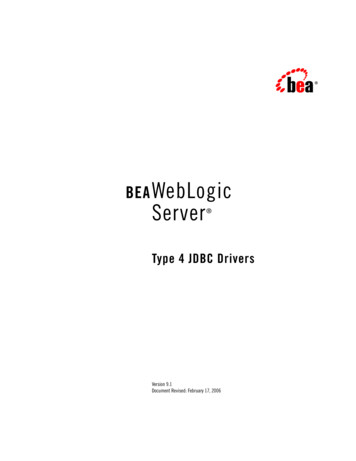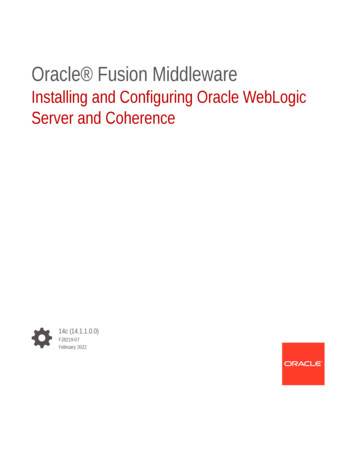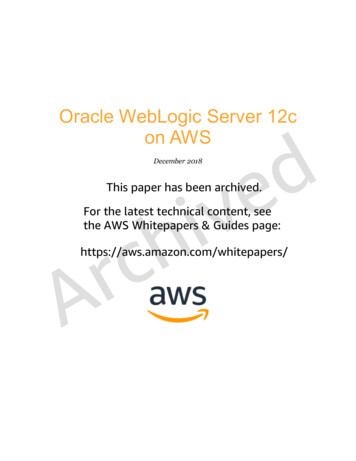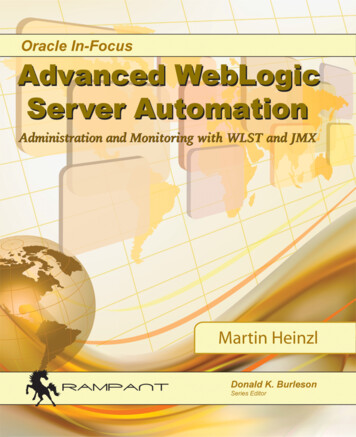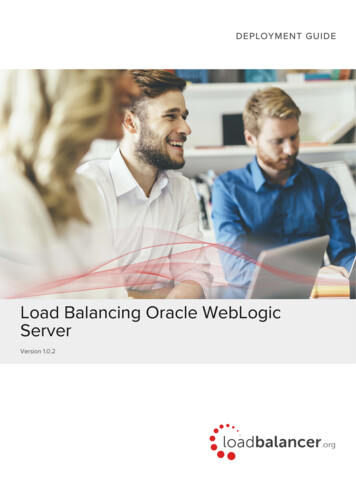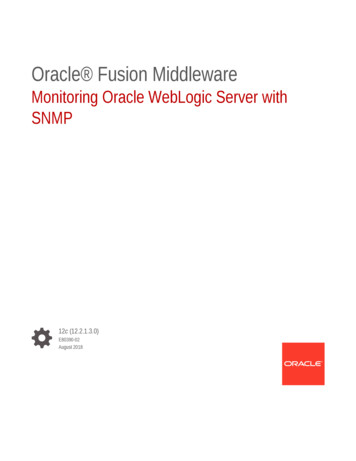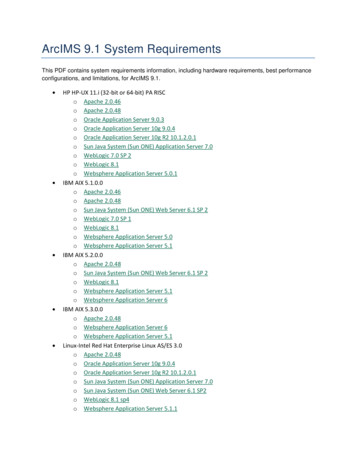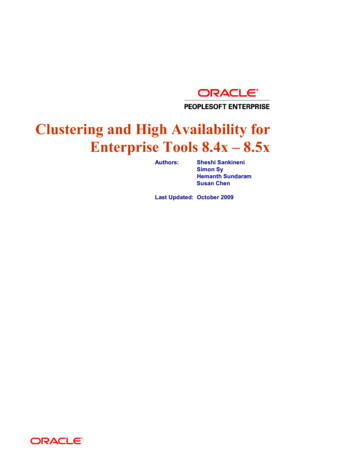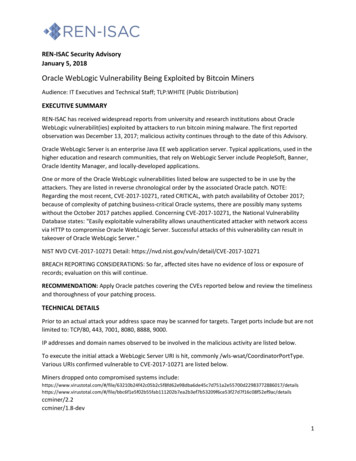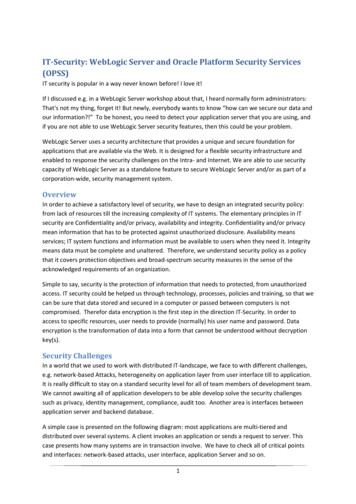
Transcription
IT-Security: WebLogic Server and Oracle Platform Security Services(OPSS)IT security is popular in a way never known before! I love it!If I discussed e.g. in a WebLogic Server workshop about that, I heard normally form administrators:That's not my thing, forget it! But newly, everybody wants to know “how can we secure our data andour information?!” To be honest, you need to detect your application server that you are using, andif you are not able to use WebLogic Server security features, then this could be your problem.WebLogic Server uses a security architecture that provides a unique and secure foundation forapplications that are available via the Web. It is designed for a flexible security infrastructure andenabled to response the security challenges on the Intra- and Internet. We are able to use securitycapacity of WebLogic Server as a standalone feature to secure WebLogic Server and/or as part of acorporation-wide, security management system.OverviewIn order to achieve a satisfactory level of security, we have to design an integrated security policy:from lack of resources till the increasing complexity of IT systems. The elementary principles in ITsecurity are Confidentiality and/or privacy, availability and integrity. Confidentiality and/or privacymean information that has to be protected against unauthorized disclosure. Availability meansservices; IT system functions and information must be available to users when they need it. Integritymeans data must be complete and unaltered. Therefore, we understand security policy as a policythat it covers protection objectives and broad-spectrum security measures in the sense of theacknowledged requirements of an organization.Simple to say, security is the protection of information that needs to protected, from unauthorizedaccess. IT security could be helped us through technology, processes, policies and training, so that wecan be sure that data stored and secured in a computer or passed between computers is notcompromised. Therefor data encryption is the first step in the direction IT-Security. In order toaccess to specific resources, user needs to provide (normally) his user name and password. Dataencryption is the transformation of data into a form that cannot be understood without decryptionkey(s).Security ChallengesIn a world that we used to work with distributed IT-landscape, we face to with different challenges,e.g. network-based Attacks, heterogeneity on application layer from user interface till to application.It is really difficult to stay on a standard security level for all of team members of development team.We cannot awaiting all of application developers to be able develop solve the security challengessuch as privacy, identity management, compliance, audit too. Another area is interfaces betweenapplication server and backend database.A simple case is presented on the following diagram: most applications are multi-tiered anddistributed over several systems. A client invokes an application or sends a request to server. Thiscase presents how many systems are in transaction involve. We have to check all of critical pointsand interfaces: network-based attacks, user interface, application Server and so on.1
On these grounds, we need to use an enterprise security framework that allows applicationdevelopers to pick and choose from a full set of reusable and standards based security services thatallow security, privacy, and audit. Oracle Platform Security Services (OPSS) is a security frameworkthat runs on WebLogic Server and is available as part of WebLogic Server. It combines the securityfeatures of BEA‘s internal security (WLS Oracle Entitlement Server (OES)) and the OAS (HavaPlatform Security (JPS) - earlier JAZN) to provide application developers, system integrators, securityadministrators, and independent SW vendors with a comprehensive security platform framework forJava SE and Java EE applications. In this form, Oracle is able to suggest a uniform enterprise securitypolicy and a self-contained and independent framework with Identity management and auditservices across the enterprise. The heart of whole system beats on WebLogic Server.WebLogic Server provides authentication, authorization, and encryption services with which you canguard these resources. These services cannot provide protection, however, from an intruder whogains access by discovering and exploiting a weakness in your deployment environment. Therefore,whether you deploy WebLogic Server on the Internet or on an intranet, it is a good idea to contact anindependent security expert to go over your security plan and procedures, audit your installedsystems, and recommend improvements.2
OPSS ArchitectureAs we discussed security-weblogic-server 1/),OPSS is Oracle proposals regarding enterprise security services. It is as a framework that provides acomprehensive set of security services. These services based on Java technologies and have aconsistent approach for design and apply security policies to Java EE and resources. We look at OPSSarchitecture from two different perspectives, which are connected to each other very closely. I try toreview the advantages of OPSS for developers and administrators from Application’s perspective andpresent the cooperating of technology components such as LDAP, Application Server and OracleFusion Middleware from Component’s perspective. Thereby, we can determine the main OPSS’sbenefits that Oracle says: Allows developers to focus on application and domain problemsSupports enterprise deploymentsSupports several LDAP servers and SSO systemsIs certified on the Oracle WebLogic ServerPre-integrates with Oracle products and technologiesApplication’s point of viewOracle Platform Security Services (OPSS) is both a security framework exposing security services andAPIs, and a platform offering concrete implementation of security services. It includes theseelements: Common Security Services (CSS), the internal security framework on which Oracle WebLogicServer is based Oracle Platform Services User and Role APIs Oracle Fusion Middleware Audit FrameworkFigure 1 Application's perspective illustrations OPSS‘s architecture from application point of view.Such architecture allows OPSS to support different security and identity systems without changingthe APIs. OPSS is integrated with Oracle Fusion Middleware‘s management tools to administrate andmonitor the security policies implemented in the underlying identity management infrastructure.Therefore, OFM technologies such as Oracle SOA, Oracle WebCenter Suite, Oracle ApplicationDevelopment Framework (ADF), Oracle Web Services Manager (OWSM) and could use OPSScapacities.OPSS offers abstraction layer APIs those isolate developers from security and identity managementimplementation details. In this way, developer can invoke the services provided by OPSS directlyfrom the development environment (e.g. JDeveloper) using wizards. Admin can configure theservices of OPSS into the WLS. As you see in Figure, the uppermost layer consists of Oracle WebLogicServer and the components and Java applications running on the server; below this is the API layerconsisting of Authentication, Authorization, CSF (Credential Store Framework), and User and RoleAPIs, followed by the Service Provider Interface (SPI) layer and the service providers forauthentication, authorization, and others. The final and bottom layer consists of repositoriesincluding LDAP and database servers.3
Figure 1 Application's perspectiveOFM-Component’s point of viewFigure 2 OFM-Component's perspective shows the various security components as layers. The toplayer includes the OPSS security services; the next layer includes the service providers, and thebottom layer includes the OPSS security store with a repository of one of three kinds. OPSS providesauditing capabilities for components too.The second layer [Security Services Provider Interface (SSPI)] has the capability that works with JavaEE container security – named Java Authorization Contract for Containers (JACC) mode and inresource-based (non-JACC) mode, and resource-based authorization for the environment.SSPI is a set of APIs for implementing pluggable security providers. A module implementing any ofthese interfaces can be plugged into SSPI to provide a particular type of security service. Therefore,OPSS has a consistent structure and is able to meet the requirements for integrating JEE Applicationsgenerally and specially OFM-Components and Oracle Security technologies, such as OAM, OID and soon.4
Figure 2 OFM-Component's perspectiveIT-Security (Part 3): WebLogic Server and Java Security Features1WebLogic Server supports the Java SE and Java EE Security to protect the resources of whole system.The resources could be Web applications, Uniform Resource Locator (URL), Enterprise JavaBeans(EJBs), and Connector components.Java SE capabilities: Security APIsJava uses APIs to access security features and functionality and its architecture contains a large set ofapplication programming interfaces (APIs), tools, and implementations of commonly-used securityalgorithms, and protocols. This delivers the developer a complete security framework for writingapplications and enables them to extend the platform with new security mechanisms.2Java Authentication and Authorization Services (JAAS)WebLogic Server uses the Java Authentication and Authorization Service (JAAS) classes toconsistently and securely authenticate to the client. JAAS is a part of Java SE Security APIs and a setof Java packages that enable services to authenticate and enforce access controls upon users and /orfat-client authentication for applications, applets, Enterprise JavaBeans (EJB), or servlets.JAAS uses a Pluggable Authentication Module (PAM) framework, and permits the use of new orupdated authentication technologies without requiring modifications to the application. Therefore,only developers of custom Authentication providers and developers of remote fat client applicationsneed to be involved with JAAS directly. Users of thin clients or developers of within-container fatclient applications do not require the direct use or knowledge of JAAS.JAAS LoginModulesAll LoginModules are responsible for authenticating users within the security realm (we are going todiscuss about that later) and for populating a subject with the necessary principals (users/groups).LoginModules contains necessary methods for Login Context, Accounts, Credentials, configuration ofthem, and different ways to exception handling. Each Authentication providers will be configured in asecurity realm, its LoginModules will store principals within the same subject too. I try to present that5
with an example: Via WebLogic Server Admin Console: Home myDomain Domain Structure clickon Security Realms and then create a new realm “Moh Realm-0” and then click on “OK”Figure 1 create a new RealmSelect new realm and then click on tab “provider”, and then click on “New”, in order to create a newprovider:Figure 2 open the new RealmIn this use case, we select type: “WebLogic Authentication Provider” and give a name e.g.“DefAuthN”, then “OK”. The WebLogic Authentication provider is configured in the default securityrealm (myrealm). The WebLogic Authentication provider allows you to edit, list, and manage users,groups, and group membership. User and group information is stored in the embedded LDAP server.36
Figure 3 create a new Authentication ProviderAfter define “Provider”, we have to restart Admin Server. Now, we can check and compare users ofnew realm (Moh Realm-0) with default realm (myrealm) of WebLogic. For myrealm, Icreated a newuser named “userDOAG” and we see the following list there (Home Summary of Security Realms myrealm Users and Groups)Figure 4 users of myrealm7
But I didn’t create same user for Moh Realm-0 (Home DefAuthN Summary of Security Realms Moh Realm-0 Users and Groups):Figure 5 users of Moh Realm-0It shows, that we can use security provider in different gatherings und expand our security realmwith additional user, groups, and security providers. We are working on it in next part of this article.JAAS Control FlagsThe JAAS Control Flag attribute determines how the LoginModule for the WebLogic Authenticationprovider is used in the login sequence. The values for the Control Flag attribute are as follows: Home Summary of Security Realms Moh Realm-0 Providers DefAuthN8
Figure 6 Control flags via Admin Consol REQUIRED - This LoginModule must succeed. Even if it fails, authentication proceeds downthe list of LoginModules for the configured Authentication providers. This setting is thedefault. REQUISITE - This LoginModule must succeed. If other Authentication providers areconfigured and this LoginModule succeeds, authentication proceeds down the list ofLoginModules. Otherwise, return control to the application. SUFFICIENT - This LoginModule needs not succeed. If it does succeed, return control to theapplication. If it fails and other Authentication providers are configured, authenticationproceeds down the LoginModule list OPTIONAL - The user is allowed to pass or fail the authentication test of these Authenticationproviders. However, if all Authentication providers configured in a security realm have theJAAS Control Flag set to OPTIONAL, the user must pass the authentication test of one of theconfigured providers.4Now, we can focus on two important JAAS-tasks: authentication and authorization of users 5IT-Security: WebLogic Server and Authentication – Part 4As I mentioned, JAAS is able for two important tasks: authentication and authorization of users. Now,let us see more about them.9
Authentication: Who are you?Authentication verifies that the user is who she/he claims to be. But user is also an entity and couldbe a person, a software entity or other instances of WebLogic Server (so called “resources”). WLSperforms proof material typically through a JAAS LoginModule and JAAS authentication isimplemented in a pluggable method. A user’s identity is confirmed through the credentials presentedby that user, such as:1. something one has, e.g. credentials issued by a trusted authority such as a passport or a smartcard2. something one knows, e.g. a shared secret such as a password,3. something one is, e.g. biometric informationA combination of several types of credentials is known as "strong" authentication; e.g. using an ATMcard (credential 1) with a PIN or password (credential 2).6Types of AuthenticationWebLogic Server is able to perform the different types of authentication, because it can use theWebLogic Authentication provider or custom security providers. Administrators are able to define auser and password with WebLogic Authentication provider. The all passwords will be encrypted.Users may be placed into groups or be related with security roles.Basic Authentication: Username/PasswordBasic authentication is defined via The Internet Engineering Task Force (IETF ) so: “The "basic"authentication scheme is based on the model that the client must authenticate itself with a user-IDand a password for each realm. The realm value should be considered an opaque string which canonly be compared for equality with other realms on that server. The server will service the requestonly if it can validate the user-ID and password for the protection space of the Request-URI. Thereare no optional authentication parameters.”7In this type of authentication will be user/password requested. WebLogic scenario looks like this: theuser and sent ID/PW to WebLogic Server. It checks them and if it is reliable, gives access to theprotected WebLogic resource. In background, WebLogic Server checks the security policy of theWebLogic resource and the principal (that the user has been assigned) to make sure that the user hasthe obligatory permissions to continue.10
In addition, you can use https. User/password will be encrypted between client and server throughSSL communication. It is an extra advantage that the transaction between client and server will notbe performed in clear text.Certificate AuthenticationWe are going to discuss about Secure Sockets Layer (SSL) in the next articles. SSL delivers protectedconnections. The SSL-communicating authenticate identity of two entity and/or application thatcommunicate through a network connection. In addition, the whole SSL-communication is encrypted.WebLogic Server provides a pure-Java implementation of SSL and supports One-Way- and Two-WaySSL authentication.Simple to say, if a WLS to authenticate to a client, then we have a One-Way SSL. If a client toauthenticate to a WLS, then we have Two-Way SSL. One-Way SSL is obligatory but Two-Way SSL isoptional. During “handshaking” exchange the applications and/ or entities digital certificates. Thedigital certificate is supplied by an entity, which authenticates the identity of WebLogic Server.Afterwards, the both sides, also WebLogic Server and client, decide on the encryption algorithms tobe used. As third step, SSL-connection generates the encryption keys to be used for the remainder ofthe session. The encryption keys is a hybrid encryption approach that it uses advantages ofasymmetric and symmetric encryption therefore, it is known as a good combination between betterperformance and security in network communication.Digest AuthenticationWe are going back to this topic for deeper discussion. As an introduction, we can start with thedefinition of The Internet Engineering Task Force (IETF ): “Like Basic Access Authentication, theDigest scheme is based on a simple challenge-response paradigm. The Digest scheme challenges usea nonce value. A valid response contains a checksum (by default, the MD5 checksum) of theusername, the password, the given nonce value, the HTTP method, and the requested URI. In thisway, the password is never sent in the clear. Just as with the Basic scheme, the username andpassword must be prearranged in some fashion not addressed by this document.”8Weblogic Server supports digest authentication and is resistant to replay attacks. “Theimplementation maintains a cache of used nonces/timestamps for a specified period of time. Allrequests with a timestamp older than the specified timestamp are rejected as well as any requeststhat use the same timestamp/nonce pair as the most recent timestamp/nonce pair still in the cache.WebLogic Server stores this cache in a database.”9I’m going to continue with Authentication’s topic in next part of IT-Secrutity and WebLogic Server.11
IT-Security (Part 5): WebLogic Server, perimeter Authentication andIdentity AssertionI tried to discuss about “perimeter authentication” in one extra part of IT-Security’s blogs, becausethis authentication’s process is an essential approach in a heterogonous world of systems,applications and technologies that they need to trust and communicate to each other. Generally, wediscussed about perimeter authentication, if a remote user requires an asserted identity and someform of proof material to an authentication server that performs the verification and then passes anartifact, or token, to the application server domain.10If we want to identify a remote user outside of the WebLogic server domain, as an authenticationserver, then we need to another approach for authenticating’s process instead basic authenticationwith username and password11. This authentication’s process is called perimeter authentication. Itestablishes trust via a passphrase, e.g. tokens. Tokens will be generated as part of the authenticationprocess of users or system processes and could have many different types and / or vendors, e.g.Kerberos and Security Assertion Markup Language (SAML). WebLogic Server is able to use thetoken(s) so that users are not requested to sign on more than once.This form of authentication operates with authentication agent. It performs an authenticationprocess that outcomes in a token. It contains the authentication information of user and guaranteesfor the user’s identity. The Figure 7 Perimeter Authentication12 presents the sequence of events inauthenticating process:Remote User sends a request with passphrase to Authentication Agent. It creates a token and sendsto WebLogic Server to access resources and / or application(s). The WebLogic Server performperimeter authentication via Identity Assertion.Figure 7 Perimeter AuthenticationWe can define the Identity Assertion provider, as a specific form of Authentication provider thatpermits users or applications to assert their identity using tokens. With other words, it supportsuser’s mappers, which map a valid token to a WLS-User. It is possible to develop your own or use athird-party security vendor's Identity Assertion providers. Identity assertion can use perimeterauthentication schemes such as the Security Assertion Markup Language (SAML), the Simple and12
Protected GSS-API Negotiation Mechanism (SPNEGO), or enhancements to protocols such asCommon Secure Interoperability (CSI) v2 and support single sign-on.13 The WebLogic Identity14:Assertion providers support the following token types (here is a selected list of token types) AU TYPE, for a WebLogic AuthenticatedUser used as a token.X509 is an ITU-T standard for a public key infrastructure (PKI) and Privilege ManagementInfrastructure (PMI) and RFC 4158 provides information and guidance for certification pathbuilding.15 X509 TYPE, for an X509 client certificate used as a token: CSI X509 CERTCHAIN TYPE, for a CSIv2 X509 certificate chain identity used as a token.“The Negotiate Identity Assertion provider is used for SSO with Microsoft clients that support theSPNEGO protocol. The Negotiate Identity Assertion provider decodes SPNEGO tokens to obtainKerberos tokens, validates the Kerberos tokens, and maps Kerberos tokens to WebLogic users. TheNegotiate Identity Assertion provider utilizes the Java Generic Security Service (GSS) ApplicationProgramming Interface (API) to accept the GSS security context via Kerberos. The Negotiate IdentityAssertion provider is for Windows NT Integrated Login.” 16 AUTHORIZATION NEGOTIATE, for a SPNEGO internal token used as a token. WWW AUTHENTICATE NEGOTIATE, for a SPNEGO internal token used as a token.“The SAML Identity Assertion providers handle SAML assertion tokens when WebLogic Server acts asa SAML destination site. The SAML Identity Assertion providers consume and validate SAML assertiontokens and determines if the assertion is to be trusted (using either the proof material available inthe SOAP message, the client certificate, or some other configuration indicator).” 17 I am going backto SAML topic in an additional article(s). SAML ASSERTION B64 TYPE, for a Base64 encoded SAML.assertion used as a token. SAML ASSERTION DOM TYPE, for a SAML DOM element used as a token. SAML ASSERTION TYPE, for a SAML string XML form used as a token. SAML2 ASSERTION DOM TYPE, for a SAML2 DOM element used as a token. SAML2 ASSERTION TYPE, for a SAML2 string XML form used as a token. SAML SSO CREDENTIAL TYPE, for a SAML string consisting of the TARGET parameterconcatenated with the assertion itself and used as a token.I introduced about Digest Authentication18 in previous blog and WebLogic supports für Web Serviceapplication the following Digest type: WSSE PASSWORD DIGEST TYPE, for a username token with a password type of passworddigest used as a token.The Authentication and Identity Assertion ProcessNow, we can compare Basic authentication Process with Identity Assertion Process. On Figure 8Authentication Process (Principal Validation Process)19 shows the authentication process for a fatclient login. A user attempts to log into a system using a username/password combination. WebLogicServer establishes trust by calling the configured Authentication provider's LoginModule, whichvalidates the user's username and password and returns a subject that is populated with principalsper Java Authentication and Authorization Service (JAAS) 20 requirements. In this way, an13
authentication context will be established and user can access to certain resource and / orcomponents in WebLogic Domain.Figure 8 Authentication Process (Principal Validation Process)Figure 9 Perimeter Authentication presents the perimeter authentication process21.1. A token from outside of WebLogic Server is passed to an Identity Assertion provider that isresponsible for validating tokens of that type and that is configured as "active".2. If the token is successfully validated, the Identity Assertion provider maps the token to aWebLogic Server username, and sends that username back to WebLogic Server, which thencontinues the authentication process as described above. It requires the same components,but also adds an Identity Assertion provider. Specifically, the username is sent via a JavaAuthentication and Authorization Service (JAAS) CallbackHandler and passed to eachconfigured Authentication provider's LoginModule, so that the LoginModule can populatethe subject with the appropriate principals.Figure 9 Perimeter AuthenticationIf you compare the two ways of authentication, then you can find out a core security characteristic ofWebLogic Server too. It is mean; WebLogic Server security architecture has a consistence modular14
structure and therefore can response rapid to new challenges and technologies in security area. Thisarchitecture is capable to expand its features und integrate new security components in itself.References Oracle Fusion Middleware 11.1.1.5, Security Guideshttp://docs.oracle.com/cd/E21764 01/security.htm Oracle Fusion Middleware Understanding Security for Oracle WebLogic Server 11g Release1 (10.3.5) http://docs.oracle.com/cd/E21764 01/web.1111/e13710/toc.htm Oracle Fusion Middleware Securing Oracle WebLogic Serverhttp://docs.oracle.com/cd/E21764 01/web.1111/e13707/toc.htm Oracle Platform Security Services 11gR1 (White /id-mgmt/opss-tech-wp-131775.pdf IT Security Guidelines, IT Baseline Protection in brief, Federal Office for Information Security See too: Do you forget your WebLogic Server password? No o-problem/ Oracle Fusion Middleware Understanding Security for Oracle WebLogic Server 11g Release1 (10.3.5) http://docs.oracle.com/cd/E21764 01/web.1111/e13710/toc.htm m/igf/index.html Oracle Fusion Middleware: Understanding Security for Oracle WebLogic Server 12c Release1, (12.1.1), E24484-02, January 2012:http://docs.oracle.com/cd/E24329 01/web.1211/e24484.pdf For details, see OPSS Architecture Overview in the Oracle Fusion Middleware ApplicationSecurity Guide: http://docs.oracle.com/cd/E23943 01/core.1111/e10043.pdf Oracle Access Manager Integration Guide:http://docs.oracle.com/cd/E12530 01/oam.1014/e10356/weblogic.htm1IT-Security (Part 1): ecurity-weblogic-server 1/IT-Security (Part 2): security-services-opss-2/2See: des/security/overview/jsoverview.html3More detail in: http://docs.oracle.com/cd/E24329 01/apirefs.1211/e24403/core/index.html4Oracle Fusion Middleware: Understanding Security for Oracle WebLogic Server 12c Release 1, (12.1.1),E24484-02, January 2012: http://docs.oracle.com/cd/E24329 01/web.1211/e24484.pdf5See too: Do you forget your WebLogic Server password? No no-problem/15
6See Oracle Fusion Middleware Security Overviewhttp://docs.oracle.com/cd/E23943 01/core.1111/e12889.pdfOracle Fusion Middleware 11.1.1.5, Security Guides http://docs.oracle.com/cd/E21764 01/security.htmOracle Fusion Middleware Securing Oracle WebLogic Serverhttp://docs.oracle.com/cd/E21764 01/web.1111/e13707/toc.htmOracle Platform Security Services 11gR1 (White /id-mgmt/opss-tech-wp-131775.pdf7Request for Comments: 2617: The Internet Engineering Task Force (IETF t for Comments: 2617: The Internet Engineering Task Force (IETF ):https://datatracker.ietf.org/doc/rfc2617/9Oracle Fusion Middleware Understanding Security for Oracle WebLogic Server 11g Release 1 (10.3.5)http://docs.oracle.com/cd/E21764 01/web.1111/e13710/toc.htm10Oracle Fusion Middleware: Understanding Security for Oracle WebLogic Server, 11g Release 1 (10.3.6),E13710-0611For „Basic Authentication: Username/Password“ see: 2Oracle Fusion Middleware: Understanding Security for Oracle WebLogic Server, 11g Release 1 (10.3.6),E13710-0613Oracle Fusion Middleware Developing Security Providers for Oracle WebLogic Server, 11g Release 1(10.3.6), Part Number E13718-05, http://docs.oracle.com/cd/E23943 01/web.1111/e13718/ia.htm14Oracle Fusion Middleware Developing Security Providers for Oracle WebLogic Server, 11g Release 1(10.3.6), Part Number E13718-05, http://docs.oracle.com/cd/E23943 01/web.1111/e13718/ia.htm15See: http://tools.ietf.org/html/rfc415816Oracle Fusion Middleware Developing Security Providers for Oracle WebLogic Server, 11g Release 1(10.3.6), Part Number E13718-05, http://docs.oracle.com/cd/E23943 01/web.1111/e13718/ia.htm17Oracle Fusion Middleware Developing Security Providers for Oracle WebLogic Server, 11g Release 1(10.3.6), Part Number E13718-05, http://docs.oracle.com/cd/E23943 01/web.1111/e13718/ia.htm18See 19See: http://docs.oracle.com/cd/E23943 01/web.1111/e13718/atn.htm#i114110620IT-Security (
IT-Security (Part 3): WebLogic Server and Java Security Features 1 WebLogic Server supports the Java SE and Java EE Security to protect the resources of whole system. The resources could be Web applications, Uniform Resource Locator (URL), Enterprise JavaBeans (EJBs), and Connector components. Java SE capabilities: Security APIs
